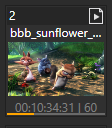•The Encoding Engine in VERTEX is based on FFmpeg. Basically, VERTEX is able to import every codec and file container that is supported by FFmpeg.
•Depending on your hardware setup, not every codec is recommended for every use case
•VETTEX supports high quality codecs like Apple ProRes, HAP/HAP-Q and Notch LC
•VERTEX automatically extracts and resamples embedded Audio
Supported Formats and Codecs
•VERTEX is based on ffmpeg to read video data - basically all video formats from ffmpeg are supported (e.g. MPEG4/H264, MPEG 2...)
•Playback of high quality codecs like Apple ProRes, HAP/Hap-Q or Notch LC is supported
•
 Choosing the right codec
Choosing the right codec
The choice of a codec depends on your projects conditions, the resolution and your quality requirements. A general statement is difficult and also does not represent the full range of projects. The choice of a codec also depends on your hardware configuration. Some codecs require more GPU power, others require more CPU power or a fast hard disk
For high quality playback we recommend to use Apple ProRes, HAP, HAP-Q or Notch LC. VERTEX comes with a native integration of HAP and Notch LC. Most parts of the encoding load is shifted to the GPU. The playback performance for especially high resolution files is great.
If there are any questions about codecs, please write us an email to vertex.support@rossvideo.com
 10 Bit Playback with Notch LC
10 Bit Playback with Notch LC
VERTEX supports 10 Bit Playback with the NOTCH LC codec. This codec is free. "It brings the equivalent of 10bit accuracy in a scrubbable codec that is extremely fast to encode and decode, with a compression ratios of around 5:1" (Source: Notch LC Website)
Proxy Files
•For each video content that you add to your project, VERTEX automatically calculates proxy files in a small and a middle quality and resolution.
•The progress of this encoding is displayed with an orange progress bar into your content tile
•Into the Render Editor you are able to switch between original file and proxy file.
Encoding and Status
•The orange progress bar into the content item in Project Explorer shows you the status of the encoding process
•By default, the amount of parallel encoding jobs into a VERTEX project is set to 1. When import multiple files, the encoding will be done one by one.
•All Proxy Files are saved into your VERTEX Project Folder. When the Encoding Process is finished, they are distributed in background to all other VERTEX Systems into a Project.
 When VERTEX is creating the proxy file of your video content, the CPU usage is higher as usual.
When VERTEX is creating the proxy file of your video content, the CPU usage is higher as usual.
When the process is finished you should observe a decrease of your PC's CPU usage.
Settings
•For each VERTEX System you can set the number of parallel encoding jobs in the Inspector.
Select your System into Project Explorer and navigate to Inspector (All-Settings Tab)
•For each VERTEX Project you are able to globally disable the encoding of proxy files
Go to Main Menu -> Edit -> Project Settings
•For each VERTEX System into your current VERTEX project, you can disable the Content Sync for Proxy Files.
Select your System into Project Explorer and navigate to Inspector (All-Settings Tab)

Proxy Files are saved into your project folder.
For each Content a Folder with an internal UUID is created into the project files subfolder Data\Content
Embedded Audio
•Embedded Audio of a Video file is extracted and resampled into a separated .wav file during import
•The audio file is stored into the VERTEX project folder.
•For you as user, there is nothing special to keep in mind - When working with this video file, VERTEX always will automatically assign the resampled Audio track to your video. But if needed, you are able to change to audio track of your clip container.
Settings
•Audio Extraction can be globally disabled for a VERTEX Project into Project Settings.
Go to Main Menu -> Edit -> Project Settings
Transcoding Presets
•Transcoding for the most common codec types is available with a simple right-click in the Project Explorer
•No complicated settings are needed: VERTEX offers you Presets with the ideal configuration for best performance in VERTEX
•Choose weather the new file should be imported as new content or as new version
How to
•select the already imported Content into the Project Explorer
•Right-Click on this Content and open the context menu
•select Transcode..
•The Transcode Settings dialog will open (c.f. below)
•Do your settings there and confirm
•Transcoding will start - including proxy files. The status is shown with a yellow progress bar in the content items tile
Transcode Settings
Presets
Choose from a list of specific codecs.
The presets for the specified format already have the optimal settings for a playback in VERTEX
 File Sizes
File Sizes
Depending on the source file, its resolution and length, new transcoded Hap files (especially hap q ) and ProRes files could have bigger file sizes! Ensure that there is enough space on your project data drive.
Export
Select between the options "Audio&Video" (default setting) ans "only Video"
Import
There a two different options how to import the new and transcoded video into your current VERTEX project:
1.As new content Item
The transcoded video will be added as a new content item into Project Explorer
The new transcoded file and its proxy files are stored into the VERTEX project folder.
2.As a new version of the current content item
The file will be transcoded into the chooses preset and is accessible as new version of the current content item
The new transcoded file and its proxy files are stored into the VERTEX project folder.
Content Encryption
•Protect your intellectual property with an integrated Digital Rights Management (DRM) tool.
•Video files (.mov - Quicktime container) can be encrypted directly inside of VERTEX
•Select between different encryption modes: a key, lock it to a license or dongle and/or fit it with an expiry date.
How to
•Rightclick on a Video file into project Explorer
•Choose "Encrypt File" from Context Menu
•The "Encryption Settings" Dialog will open
•Do your settings and choose mode (see below)
•Copy the encryption key, confirm
•VERTEX will transcode your video into a new .movx file
•If not automatically imported into project explorer open context menu on the original file and choose "Show file in File Explorer"
•Import the .movx file again
•select the file into Project Explorer
•change to Advanced Inspector Mode
•Search for Encryption Key in Inspector and enter the key
•Refresh Proxy and Cache files: Right-Click - Context Menu on the encrypted content item in Project Explorer
Settings and Modes
Normal:
File is encrypted with a passkey. The passkey is generated after clicking OK
Expiry Date:
The File receives an expiry date, for how long the file can be opened
License list:
The file will only run on systems with a certain license key. The license key can be entered into the list field
Dongle:
The file can only be opened if the dongle plugged in during encryption is plugged in during playbac
 Notch LC
Notch LC






